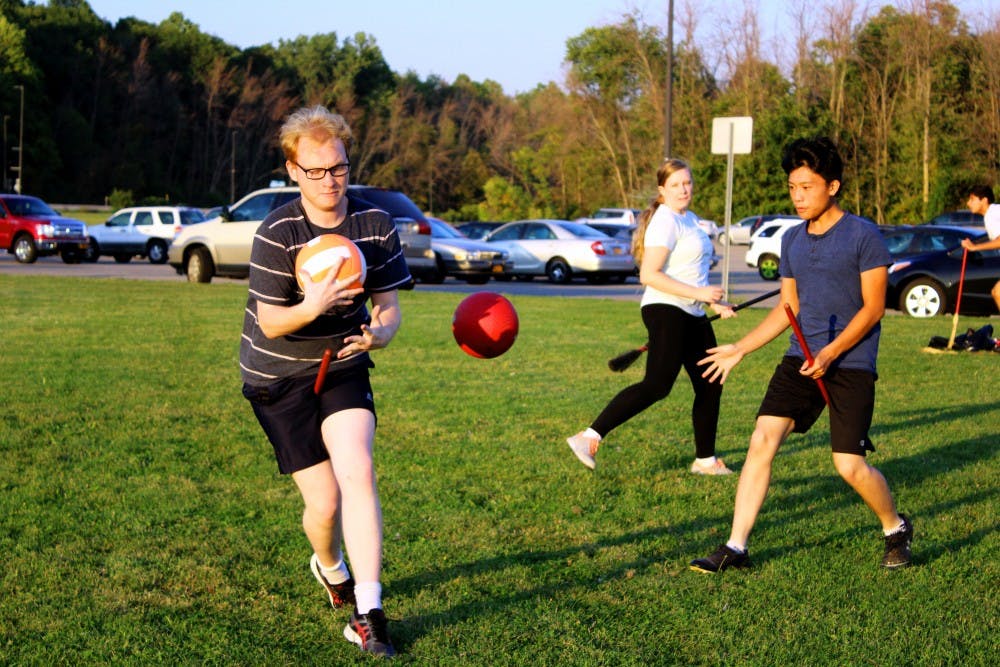Buffalo Quidditch has been turning heads on campus for over half a decade with their broomstick-involved play.
The “Harry Potter”-inspired sport is an amalgam of several other sports with a fantastical twist. While its origins are fictitious, the game is very real to its practitioners who play with all of the intensity of the fiercest Death Eater.
Brian Scimeca, a senior business administration major, serves as the team’s captain. He isn’t a “Potter” fan, but still takes pride in the sport and its roots.
“I read up to the second book and I got bored through the third and stopped,” Scimeca said. “Somehow, I’m captain of the Quidditch team without really liking ‘Harry Potter.’ We’re not a ‘Harry Potter’ fan club as much as a sport but we know where we came from.”
The intricacies of the game can seem overwhelming, initially, but some may find it easily comparable to other popular sports.
Quidditch is played on a field similar to soccer and football, with seven players per team and three balls are in play at all times.
Each team has three chasers. These players are responsible for passing, scoring and defending the quaffle, or volleyball. Three hoops are at each end of the field and teams are awarded 10 points per goal.
The teams are stacked with two beaters. A beater is responsible for hitting players off of their brooms with a dodgeball -- or bludger -- and making them temporarily unable to continue play.
Each team has a keeper and a seeker. The keeper’s goal is to keep the quaffle out of the hoop, much like the goalie in soccer, but they still have to participate offensively when needed.
The seeker’s job is obtaining the snitch, which is a tennis ball in a sock. The snitch is released 17 minutes into the game, attached to a neutral player. Whoever grabs it from the player is awarded 30 points and the game ends.
Dana Glantz, a grad student studying linguistics, is one of the Quidditch team’s beaters and has been with Buffalo Quidditch since her freshman year.
Glantz sees Quidditch as a combination of several sports but thinks its numerous rules set it apart.
“I think it has qualities of a lot of sports. We have the subbing patterns from hockey and it seems similar to soccer, basketball, and rugby,” Glantz said. “But as far as the rules, I have yet to find a sport that’s similar. I was a certified referee and I still don’t understand them. They’re always changing. We’re on rulebook 10 or 11 right now,” Glantz said.
Glantz has been involved since her freshman year, but newcomer Chloe Matecki, a freshman pharmacy major, is enjoying her time with the team so far.
“I heard about it on a tour of UB because they were playing during a tour,” Matecki said.
“The tour guide was like ‘let me explain’ and I was like ‘oh no, I know exactly what that is.’ I’ve known since I decided on UB that I wanted to try and find it.”
Matecki doesn’t consider herself a “sporty” person but rather a “Potter” fan looking to socialize. She still considers Quidditch a difficult sport.
“I almost got a concussion two weeks ago. I was full-force tackled by someone that hit me right in the chest,” Matecki said. “On their way down, they elbowed me right in the left temple, so I couldn’t see straight for like 25 minutes. But it was ‘almost’ [a concussion]. It’s a generally safe sport.”
Team captain, Brian Scimeca, stresses that Quidditch is a full contact sport. The rare injuries that do happen are only a testament to the game’s intensity.
“A player got hit at our last tournament and separated his shoulder,” Scimeca said. “Quidditch is normally a safe sport but accidents happen and rough tackles happen. It’s intense. Think of it with the intensity of rugby.”
Buffalo Quidditch is a community team and is part of the Snowbelt Conference, which consists of colleges from the Western New York area. The team faces RIT, Syracuse, Nazareth and Cortland among other schools.
Outside of the conference, the team is part of the northeast region. They face Boston College, RPI, Emerson and other schools during the northeast regionals yearly in order to secure a spot at the national championship.
Buffalo Quidditch may not be national champions right now but they hope to build a larger team and increase student involvement.
“I’m super happy I got involved,” Matecki said. “I’m a commuter so this is something that keeps me on campus and it gives me friends who aren’t just in my three classes during the week. I recommend it even if you aren’t sporty. I have some physical talent like most humans do but I’m getting better. There’s no experience required.”
Buffalo Quidditch meets Tuesdays and Thursdays from 6:00-7:30pm by Governors Parking Lot E.
Brenton Blanchet is the asst. arts editor and can be reached at Brenton.Blanchet@ubspectrum.com

Brenton J. Blanchet is the 2019-20 editor-in-chief of The Spectrum. His work has appeared in Billboard, Clash Magazine, DJBooth, PopCrush, The Face and more. Ask him about Mariah Carey.





